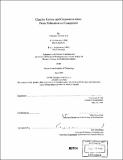| dc.contributor.advisor | Mark Jarzombek. | en_US |
| dc.contributor.author | Lai, Constance Chunlan, 1972- | en_US |
| dc.contributor.other | Massachusetts Institute of Technology. Dept. of Architecture. | en_US |
| dc.date.accessioned | 2012-01-12T19:20:07Z | |
| dc.date.available | 2012-01-12T19:20:07Z | |
| dc.date.copyright | 1999 | en_US |
| dc.date.issued | 1999 | en_US |
| dc.identifier.uri | http://hdl.handle.net/1721.1/68350 | |
| dc.description | Thesis (S.M.)--Massachusetts Institute of Technology, Dept. of Architecture, 1999. | en_US |
| dc.description | Includes bibliographical references (p. 148-151). | en_US |
| dc.description.abstract | This thesis looks at a variety of projects done by Charles and Ray Eames that emphasize their interest in communication leading up to their 1953 film A Communications Primer. The significance of this film is threefold: One, it is the first film the Eameses produced that showcased, albeit briefly, the modern digital computer. Two, it was made for an audience of architects to expose the profession to the concept of communication theory. Three, the Eameses's, and specifically Charles', interest in using computers in the architectural and city planning design processes can be traced back to this film. The Eameses's interest in computers and architecture has been documented previously but for the most part, as separate interests. This thesis contributes to the current knowledge of the Eameses by elaborating further on Charles' interest in computers in relation to architecture. It will also present original evidence in the form of a letter that Charles Eames wrote in 1954 to Ian McCallum. The letter is located at the Eames Archives at the Library of Congress in Washington, DC. The structure of this thesis traces the various nuances of the word "communication," and how these ideas either directly or indirectly influenced the making of the film A Communications Primer. First, parallels are drawn between John Dewey's philosophies on communication, education and democracy and the Eameses' earlier architectural proposals for "information centers" in which communication is encouraged. Second, the visual execution of the Eameses' educational projects is traced to the Bauhaus commitment to a universal visual language and Gyorgy Kepes' ideas of visual communication. Third, the parallels between the Eameses' hope for interdisciplinary exchange and the scientific movement, Cybernetics, are examined. Finally, the last definition of the word "communication" to be explored is the scientific and mathematical nuance of the word proposed by Claude Shannon's mathematical theory of communication and the various interpretations of it. This mathematical theory is of particular importance because it is the basis for the content of the film A Communication Primer. | en_US |
| dc.description.statementofresponsibility | by Constance Chunlan Lai. | en_US |
| dc.format.extent | 151 p. | en_US |
| dc.language.iso | eng | en_US |
| dc.publisher | Massachusetts Institute of Technology | en_US |
| dc.rights | M.I.T. theses are protected by
copyright. They may be viewed from this source for any purpose, but
reproduction or distribution in any format is prohibited without written
permission. See provided URL for inquiries about permission. | en_US |
| dc.rights.uri | http://dspace.mit.edu/handle/1721.1/7582 | en_US |
| dc.subject | Architecture. | en_US |
| dc.subject | Eames, Charles | en_US |
| dc.subject | Eames, Ray | en_US |
| dc.title | Charles Eames and communication : from education to computers | en_US |
| dc.type | Thesis | en_US |
| dc.description.degree | S.M. | en_US |
| dc.contributor.department | Massachusetts Institute of Technology. Department of Architecture | |
| dc.identifier.oclc | 43627656 | en_US |
